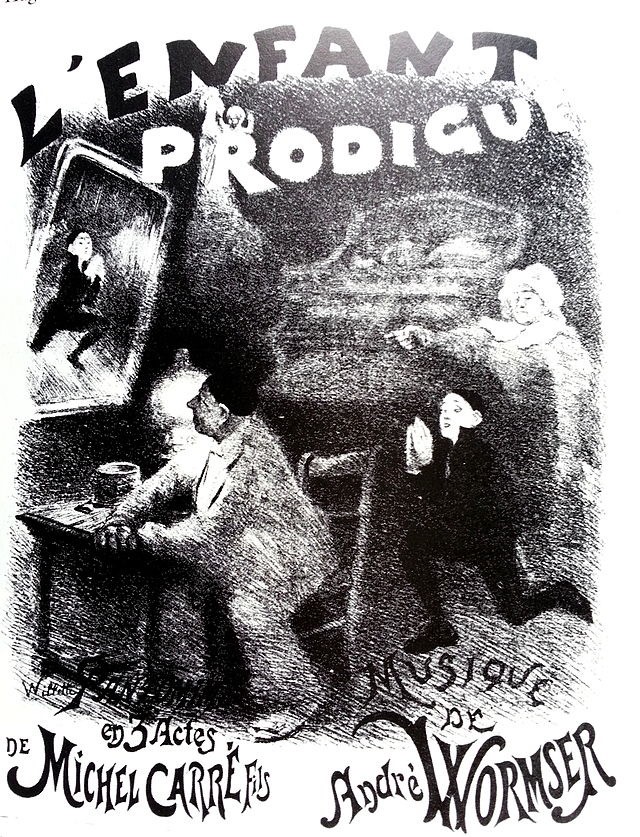Cercle Funambulesque
Unless otherwise stated, the quotes in this blog post are from an article written by Irene Mawer in The Link, which contained the newsletter of the Ginner-Mawer School of Mime and Movement, Miss Mawer wrote an article about a group of French theatre people called the Cercle Funambulesque (1).
From Wikipedia: “The Cercle Funambulesque (1888-1890)—roughly translatable as “Friends of the Funambules”[1]—was a Parisian theatrical society that produced pantomimes inspired by the Commedia dell’Arte, particularly by the exploits of its French Pierrot. Among its successes was L’Enfant prodigue (1890).”
In her article, Mawer says that she owns a rare copy of a book about the history of the Cercle Funambulesque (she does not name the book, but she widely quotes passages from the book that were written by Felix Galipaux, who according to Wikipedia was a founding member of the Cercle Funambulesque, so perhaps the author of the book was Galipaux). Mawer states that the book used to belong to Gordon Craig, and bears his signature. This, presumably, is Edward Gordon Craig (1872-1966), an actor and theatre designer, who was the son of the famous actress, Ellen Terry (1847-1928) and who supported Mawer’s work: “He was appreciative of the work of Mawer” (2).
Gordon Craig was part of the Ginner-Mawer circle and his mother (Ellen Terry) was friends with Marguerite Steen, who, I believe, trained at Ginner-Mawer and then taught dance in Yorkshire. There was a demonstrable connection between Ginner-Mawer and Yorkshire, with Ginner-Mawer stalwart Miss Doris McBride being from there – she was already a solid member of staff by 1924, which would be approximately the time that Steen would have been there, and my own teacher, Nora Gregorious-Brown/Nora Durling working in Leeds around the same time.
Mawer continues in the article, that the most famous of the Cerce Funambulesque productions was L’Enfant Prodigue and in the book, written in Edward Gordon Craig’s handwriting are some words about the production “This came to London, Mlle. Jane May as Pierrot fils. Performance at the Prince of Wales Theatre, near Leicester Square. I went to see it with E.T. And H.I. (Ellen Terry and Henry Irving). The younger folk loved it and raved about it. The others, H.I. And E.T., raised their eyebrows a little.”
The Cercle Funambulesque were inspired by Jean-Gaspard Deburau, who had been the shining light of French pantomime (not the same thing as the Christmas pantomimes in England). After Deburau died, pantomime had been replaced by Vaudeville, so the Cercle Funambulesque revived the old Deburau style of entertainment because they were devotees of the cult of Pierrot.
Here is a quote from the book owned by Edward Craig, that Mawer chose to reproduce in her article “Felix Galipaux, writing on how to produce a Mime, says: … The art of pantomime has many affinities with sculpture. It is sculpture alive, animated with nerves, with blood, with laughter and tears.”
Mawer also quotes Galipaux as saying fat people shouldn’t be mimes (p.4); pointing out that he said that you need a mobile expression, and long limbs which are frail and delicate, supple and free. Eyes should be dark. Galipaux continues “Intelligence, even a remarkable intelligence, is not enough for the artist who wishes to play pantomime. He must have physical gifts as well. First of all, a face which is at all heavy is impossible. What can be done without mobile expression of the mask? So let the thin rejoice! And rejoice also that not only must your face be long, but your limbs, too, should be frail and delicate, supple and free…Happy is the possessor of an expressive face.”
Felix Galipaux warmths to his theme: “I should not advise delicate people to become mimes, for this form of theatrical art is difficult, and it is also terribly tiring, although contortions and acrobatics are no longer required.”
Well, that explains it then, that is why I never made it as a mime, ha ha ha.
The quotation continues “I have a holy horror of the actor, who in mime is always posing, and takes a sculptured attitude to demand a boiled egg! There is no need to drape oneself into attitudes to express the ordinary actions of every-day life. The talented mime plays with his eyes rather than with his arms.” Oh, this is so much Irene Mawer – definitely her opinion, I think, as this is exactly what I was taught. I find it difficult to watch gormless performers who gurn and simper on the stage for no reason at all.
“Above all, be modern!” Now, that is an interesting quote for Irene Mawer to have included. I think of her as being old fashioned and so many people who write about her are critical of the Ginner-Mawer School, saying that they failed because they did not move with the times. However, she wrote this article in 1937, when she was 44 years old and the Ginner-Mawer School was thriving. Perhaps she wasn’t always old fashioned.
(1 – The Link, October 1937, pp. 3 – 5)
(2. Craig, Edward Gordon (1977), Craig on Movement and Dance, (edited by Arnold Rood), London: Dance Books in Evans, Mark, Movement Training for the Modern Actor, p.92 London Routledge http://www.routledge.com/books/details/9780415963671)
———-end———

